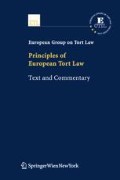Preview
Unable to display preview. Download preview PDF.
References
B.A. Koch/ H. Koziol, Comparative Conclusions, in B.A. Koch/ H. Koziol (eds.), Unification of Tort Law: Strict Liability (2002, hereafter cited as PETL Strict Liability) 395 (no. 2).
W.V.H. Rogers, England, PETL Strict Liability, 101 (no. 1). See also B.A. Koch/H. Koziol, Comparative Conclusions, PETL Strict Liability, no. 156.
See also the Basic Norm, Art. 1:101 no. 17.
See supra fn. 1.
B.A. Koch/ H. Koziol, Austria, PETL Strict Liability, 9 (no. 25); J. Fedtke/U. Magnus, Germany, PETL Strict Liability, 147 (no. 14 et seq.); F. Busnelli/G. Comandé, Italy, PETL Strict Liability, 205 (no. 7); P. Widmer, Switzerland, PETL Strict Liability, 323 (no. 21–22). But see the Italian practice of interpreting the wording of Art. 2050 Codice civile (“dangerous activities”) rather broadly: F. Busnelli/G. Comandé, Italy, PETL Strict Liability, no. 43 et seq.
Cf. the references to the Italian Art. 2050 Cod. civ. in the previous footnote.
S. Galand-Carval, France, PETL Strict Liability, 127 (no. 10).
“The absence of any strict liability for road accidents is perhaps the most marked difference between English law and that of most European countries.” W.V.H. Rogers, England, PETL Strict Liability, 101 (no. 25).
Cf. the inventory by B.A. Koch/ H. Koziol, Comparative Conclusions, PETL Strict Liability, no. 4–45.
Cf. Restatement (Third) of Torts: Liab. Physical Harm, § 24 cmt. a.
See also the broad use of the word “activity” in Art. 3:101 (“activity” as encompassing “activity or conduct” for the purpose of these Principles).
See supra fn. 7.
Restatement (Third) of Torts: Liability for Physical Harm (Basic Principles), § 20 cmt. j.
Restatement (Third) of Torts: Liab. Physical Harm, § 20 cmt. j.
Restatement (Third) of Torts: Liab. Physical Harm, § 20 cmt. j.
Schwartz, USA, PETL Strict Liability, 351 (no. 17).
B.A. Koch/ H. Koziol, Comparative Conclusions, PETL Strict Liability, no. 98.
B.A. Koch/ H. Koziol, Comparative Conclusions, PETL Strict Liability, no. 100–102.
B.A. Koch/ H. Koziol, Comparative Conclusions, PETL Strict Liability, no. 75.
See Restatement (Third) of Torts: Liab. Physical Harm, § 20 cmt. e and the Reporters’ Note thereto.
“[B]lasting in a developed area of the city creates a highly significant risk in a way that blasting on a deserted mountainside does not.” Restatement (Third) of Torts: Liab. Physical Harm, § 20 cmt. k.
See the inventory by B.A. Koch/ H. Koziol, Comparative Conclusions, PETL Strict Liability, no. 4 et seq.
Supra at fn. 8.
Art. 50 para. 2 defines the dangerousness of an activity necessary to trigger strict liability under para. 1. It concludes by saying that such dangerousness is particularly given in those cases where special legislation has already introduced strict liability “for comparable risks.”
Author information
Authors and Affiliations
Rights and permissions
Copyright information
© 2005 Springer-Verlag/Wien
About this chapter
Cite this chapter
Busnelli, F.D. et al. (2005). Strict Liability. In: Principles of European Tort Law. Springer, Vienna. https://doi.org/10.1007/3-211-27751-X_6
Download citation
DOI: https://doi.org/10.1007/3-211-27751-X_6
Publisher Name: Springer, Vienna
Print ISBN: 978-3-211-23084-8
Online ISBN: 978-3-211-27751-5
eBook Packages: Humanities, Social Sciences and LawLaw and Criminology (R0)

